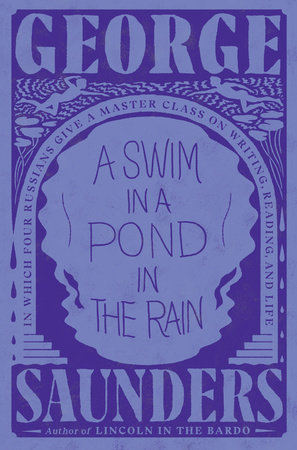A Swim in a Pond in the Rain
- By George Saunders
- Random House
- 432 pp.
- Reviewed by Josh Denslow
- February 13, 2022
The Booker Prize-winning novelist explores how some of the greats spun their magic.

I am perhaps the perfect audience for George Saunders' new book, A Swim in a Pond in the Rain: In Which Four Russians Give a Master Class on Writing, Reading, and Life. Not only am I a huge fan of Saunders’ fiction, but I’ve applied to — and been rejected multiple times from — the Syracuse University MFA program where he teaches in hopes of working with him.
I am also perhaps the most imperfect audience for this book. Not only have I never read a single thing by the Russian greats spotlighted — Anton Chekhov, Leo Tolstoy, Ivan Turgenev, and Nikolai Gogol — I don't really gravitate toward craft books in general.
But this is not a normal craft book; it's structured as a conversation. Sanders doesn't only discuss these four writers and what made them great. He also includes seven complete stories for us to judge for ourselves. And since I was going into this endeavor feeling woefully deficient in my reading choices over the years, this seemed like a great opportunity to catch up.
Saunders has taught a class on the 19th-century Russian short story for the last 20 years. In the wonderfully conversational opening to the book, he describes his realization that "some of the best moments of my life, the moments during which I've really felt myself offering something of value to the world, have been spent teaching that Russian class."
He intended A Swim in a Pond in the Rain to serve as, above all, a sort of record of what he and his students had discovered over the years. And with its warm and inviting tone, I was the lucky recipient who finally got to attend a class with one of my favorite writers.
Right away, we are launched into Chekhov’s "In the Cart." And then, a page later, Saunders interjects with his thoughts about our expectations as readers and what Chekhov as writer could do with those expectations. His insight was fascinating and helped me prepare for the discussions after later stories. But I admit that, at that moment, I flipped ahead to the other stories to see if Saunders interjected like that every time. He did not. And I was relieved.
In hindsight, though, I believe it was a great choice for a reader like me; someone unaccustomed to stopping so often to think about a story while still in the middle of reading it. His prodding and jabbing after every page or two in the first story blew some dust from some unused connectors in my brain.
Plus, the wonderful thing about Saunders’ approach is that he’s utterly nonjudgmental. It didn’t matter that I wasn’t familiar with these writers or that I've never been in a writing class. Readers are encouraged to bring whatever they can to the proceedings; Saunders takes care of the rest. When I reached the end of "In the Cart," I knew he’d helped me get far more out of it than I would’ve on my own.
After each story discussion comes an afterthought in which Saunders shares more about his personal writing style, which I found to be my favorite parts of the book. These sections include a look at his revision process — which involves a daunting amount of reworking individual sentences — as well as his views on things like the “intuitive preference” of the artist and the importance of lists and patterns. (And I shall henceforth, like Saunders, refer to plot as “meaningful action.” So great.)
By the second story, Turgenev’s “The Singers,” I was grateful to be given the chance to read the piece on my own. But then a strange thing happened: As I read, I began pausing anyway.
Suddenly, I wondered what all of Turgenev’s excess description was about. I wanted to know why certain authorial choices were made; why the quiet ending worked so very well. I had so many questions and was eager to talk about them.
Luckily, everything was addressed in the post-story conversation, which really did feel like a conversation: Saunders is a generous instructor. I felt involved. Even when a particular story didn’t resonate — Tolstoy’s “Master and Man,” for one, was a bit of a slog — Saunders’ insights helped me appreciate it.
By the time I reached (and fell in love with) Chekhov’s “Gooseberries,” I was eager to take the lessons learned from closely reading these Russian masters and apply them to my own work.
In his final afterthought, Saunders explains:
“The writer and the reader stand at either end of a pond. The writer drops a pebble in and the ripples reach the reader. The writer stands there, imagining the way the reader is receiving those ripples, by way of deciding which pebble to drop in next. Meanwhile, the reader receives those ripples and, somehow, they speak to her. In other words, they’re in connection.”
I now see that connection. And while reading A Swim in a Pond in the Rain may not be the same as having a front-row seat in “that Russian class” Professor Saunders so loves teaching, it felt pretty close. For that, I’m grateful.
[Editor's note: This review originally ran in 2021.]
Josh Denslow is author of the short-story collection Not Everyone Is Special.

_80_122.png)